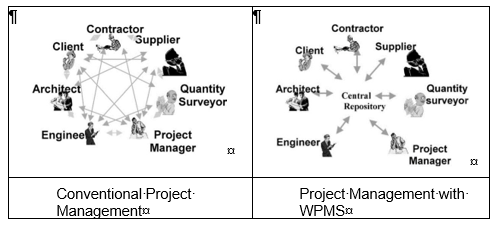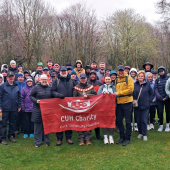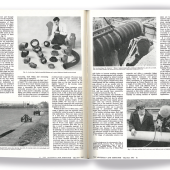Web-Based Communication for Post-Disaster Reconstruction Projects in Southeast Asia
Written by Ruhizal Roosli, Siti Salwa Mohd Ishak and Andrew Whyte.
School of Housing, Building, and Planning, Universiti Sains Malaysia (USM), Penang, Malaysia. UniSA STEM, University of South Australia, City West Campus, Adelaide SA 5000, Australia, School of Civil and Mechanical Engineering, Curtin University, Kent Street, Bentley 6102, Western Australia
Abstract
One of the problems in post-disaster reconstruction project management is late decision making due to ineffective communication among those involved in post-disaster reconstruction projects. Conventionally, among construction project management practitioners in areas of engineering, building and construction, Web-Based Communication System (WPMS) is very popular. WPMS can be described as a repository, communication station, and project processes manager. WPMS is not yet fully realized and implemented in post-disaster reconstruction in Southeast Asia region even though there is growing awareness about it. The applicability of adoption the configuration of WPMS according to the role of professionals involved is crucial to be understood to improve efficiency of ‘collaboration’ among humanitarian organisations, host country, donors and practitioners such as architects, engineers and planners. This research aimed to discover factors influencing the effective implementation of WPMS by understanding the applicability of adopting the configuration of WPMS according to the role of professionals involved. Evaluation will be made by looking at 1) workforce; 2) mechanism & 3) system infrastructure in countries like Malaysia, Indonesia, Thailand and Australia. ASEAN Coordinating Centre for Humanitarian Assistance on disaster management (AHA Centre), Indonesia is going to be the reference centre as it provides information management and dissemination for ASEAN countries through its Web Emergency Operations Centre (WebEOC).
1. Introduction
This article reports on the progress of a research project on the role of practitioners in web- based communication for post-disaster reconstruction projects in Southeast Asia. The major task accomplishments are the identification of the themes to understanding the applicability of adoption the configuration of Web-based Project Management System (WPMS) according to the role of professionals involved in Post-disaster Reconstruction (PDR). These theme will measure the level of readiness according to the existing practice. The themes are 1) workforce,
2) mechanism and 3) system infrastructure. Pilot study and some changes has been done. One major change is to use the individual interview instead of Focus Group Discussion (FGD) due to gathering focus group at one time is not possible due to current circumstances. In new engineering, building and construction projects, WPMS technology is widely acknowledged by practitioners, but not fully realized and implemented in post-disaster reconstruction. As construction projects become larger and more complex, an efficient way to deal with such intricacy is through the use of WPMS. However, WPMS is a system that normally popular among practitioners for project management of any construction project but not yet being implemented in post-disaster reconstruction projects. It is believed that WPMS is an innovative approach to addressing the issues related to the project management process in post-disaster reconstruction projects. This research is aimed to discover factors influencing the effective implementation of WPMS by understanding the applicability of adoption the configuration of WPMS according to the role of professionals involved. Therefore this study is about to foreground 'learning' in WPMS implementation, rather than its impact. This research will addressed the following overarching questions that merit future research, as follows: “How applicable it is to adopt the configuration of WPMS into current post-disaster reconstruction projects in Southeast Asia context?” The main output of this study is to promote the use of evidence-based practices by evaluating the learning process of WPMS implementation rather than to develop a concrete commercial product because the product itself (WPMS) is already available but need to be realign to the post-disaster context. The level of readiness in terms of workforce, mechanism and system infrastructure will be evaluated according to the existing practice. Recommendation will be made in the form of policy brief by highlighting the area that is still lacking in the current conventional practice. WPMS application is widely used not only for project management of post-disaster reconstruction project, but also for other projects such as product development and monitoring. The same methodology might be suitable to be used for the same type of web-based research. The level of understanding, awareness and readiness of web-based communication of actors in development can be measured and disseminated in other sectors and regions as well.
2. Literature Review
One of the major issues in the post-disaster reconstruction project is late decision making due to ineffective communication among those involved in post-disaster reconstruction project [1]. Those affiliated, or working in the field are the built environment professionals and practitioners involved in policymaking and standards, governance and regulation– they have a great need for understanding the element of technology diffusion and acceptance, and implementation program is translated in post-disaster reconstruction policy domains [2]. With better policy verification and enhancement, identification of practitioners’ role towards sustainable reconstruction offers the chance to improve the quality of buildings, the environment and living conditions in disaster-affected regions timely through better project management process [3]. In addition, this late decision making does not always cause delay in post-disaster reconstruction activities, the problem is bounded by highly complex recovery process, severe time pressure, and various kind of uncertainties and a large number of human resources of various expertise interact and cooperate, performing diverse project tasks [4]. Thus, the amount of information and documentation generated and exchanged during the construction process is massive, even on small projects that require proper handling with the proper standard operating procedure and advance in application technology [5]. This conventional policy practice has long been practicing in the PDR context with the use of many hardcopies and face-to-face meetings that require time for traveling or waiting for answers from other responsible parties as shown in Figure 1. By recognizing the role of actors in development at their respective institution or agency, aspects of workforce, mechanism and system infrastructure can be enhanced towards the use of WPMS.

Figure 1: Conventional project management versus WPMS
As construction projects become larger and more complex, an efficient way to deal with such complexity is through the use of WPMS. WPMS is a system that normally popular among practitioners for project management of any construction project but not yet being implemented in Post-Disaster Reconstruction Projects in Southeast Asia [6]. Even where the country has abundance of rules and regulations in providing housing, these are only applicable to the formal type of development or housing [7]. For example, many housing units in Kelantan were identified as informal housing especially in villages that were constructed free from obligation to these rules and regulations. It is not surprising that many houses hit by the floods were washed away. In addition, some of the projects initiated and monitored by responsible agencies also fail to protect disaster victims’ rights as in Figure 2.
Figure 2: They were designed by and awarded for construction through the contractor by JKR (Works Department)
Figure 3 shows examples of the ineffectiveness of post-disaster housing provision by the appointed agencies. These images show that even though the design has been approved and budgeted for by the agencies, the allocated building collapsed and contributed to the delays of appropriate housing provision for targeted residential areas.
Figure 3: Building collapsed
Post-disaster housing is put up after disasters by governmental and/or private institutions. There are two types of housing built after a disaster: one is principally a shelter put up for immediate relief purposes, and the other is more permanent housing for long term settlement purposes [8]. For the purpose of this study, only permanent housing provision was analysed though it is recognised that the process of housing needs to also be understood across the spectrum of temporary to permanent constructions in order to study the full extent of successes of housing programs. Permanent housing, which is the last stage of housing recovery, aims to be a final solution post-disaster to provide housing individually, which would fulfil the needs of the inhabitants in relatively much longer period of time [9]. They aim not only to serve as housing units or for basic protection but also to satisfy all necessary living requirements. Although interest in WPMS is increasing in Post-Disaster Reconstruction Projects in Southeast Asia and more humanitarian organisations, host country, donors and practitioners are becoming more aware of their existence (and to a lesser extent aware their associated benefits), the adoption, uptake, buy-in, and implementation of such tools is still relatively weak even though they aware the benefit of this system [10]. WPMS can be described as a repository, communication station, and project processes manager [11]. All information related to organisation’s projects is stored centrally in the system and in its different forms such as schedules, documents and files, text, pictures, charts, tables, videos, etc. to be available for project members anytime and anywhere. The best part of this system is the project members can update and edit the schedule online in real-time. WPMS make working together simpler and more effective. Project members can know what is going on all the time and to work together online in real-time. These systems provide a central and common place for project members to discuss and exchange information online. Discussion Forums and Discussion Boards are widely used in WPMSs and every member of the project team can create a page for discussing some topic or item related to the project with other project members. Internet will be used in order to access the secured extranet that contains all of the required information and systems as in Figure 4 & 5.
Figure 4: Simple model of WPMS
Figure 5: Functional scheme of WPMS
Many features WPMS provides for organisations in the construction industry involving all project management processes such as document management; schedule management; communications management; collaboration; risks and issues management; bidding management; project team data management; logs and timesheets management; approvals management; project portfolio management; estimating management; video-conferencing, etc. Therefore, monitoring can be done by everyone involve with access key during design stage; tendering and award stage; and construction stage [12]. Figure 5 illustrates the configuration of the available system that has been practicing in the market. The phrase “Normal Communications” refers to the traditional methods of communication such as face-to-face, phone, email, etc. The direct link between the local server and computer and communications department means that this department has control over the server in terms of administration and maintenance purposes. The red line refers to limited or restricted and secured access. Then, extranet will give access to project information and documents that are stored on the local servers anywhere. In Malaysia, MYDIMS is a disaster management system which developed to help disaster management. It consist of 4 cycle of disaster management which is mitigation, preparedness, response and recovery (Figure 6). This system comes with Real-time disaster warning, alarm monitoring and real-time information dissemination via 4 different ways of web announcement (i.e. social media, SMS, FAX, and Phone Call/ACS). The objective of MYDIMS system is to become as an instrumental in mainstreaming information and communication technology (ICT) usage for disaster management in Malaysia [13]. This system is a starting point to make disaster management more efficient and reliable in terms of comprehensive reporting; information sharing; command and control; and information dissemination. In addition, this system is also a platform for cooperation among disaster responder agencies. This system in fact is applying the concept of WPMS.
Figure 6: MYDIMS application
This MYDIMS is divided into seven (7) modules. For example, Module one (1) is Response. Response module is mainly related to operator activity that includes reporting and disaster monitoring for regular time, and information dissemination, response teaming, field agent communication at disaster. All of these modules are in fact the application of WPMS. The main module directly relevant to project management of post-disaster reconstruction is Info Manager (Figure 7). By using information manager module, user can manage all the required information including organisation, asset, hospital, shelter, and others. It also includes pre- setting information for disaster response. It will be composed of Web and Client Agent Program.
Figure 7: Information Manager
At the ASEAN level, the system is called the ASEAN Web-based Emergency Operations Centre (WebEOC) (Figure 8) administered by the ASEAN Committee on Disaster Management (ACDM/NDMO). This tool was established to communicate with 10 Member States during emergency to create a clearer line of communications by messaging board of members for disaster management professionals. Member States can monitor situation on the ground live, based on the information fed by the National Disaster Management Organisation (NDMO) of the affected country as well as the AHA Centre field teams, including the Emergency Response and Assessment Team (ERAT).
Figure 8: WebEOC
The WebEOC (Web-based Emergency Operation Centre) is a customised, web-based crisis information system. The platform enables smooth communication and seamless information sharing between the AHA Centre and NDMOs, during both emergency and non-emergency periods. Through this platform, the movement of resources, correspondence between the assisting entity and affected country, change of situations, and decisions may be accessed and recorded. The WebEOC also contains information regarding standby assets and capabilities of ASEAN Member States and other international partners. This information enables the AHA Centre to mobilise resources to the affected country in a timely and appropriate manner. The activation mechanism can be accessed anytime by approved users to communicate with 10 other ASEAN member states.
3. Methodology
The qualitative method (interviews) is a valid choice as the context, expert opinions and experiences are critical to understanding the phenomena—the roles of practitioners participating in a research project about adopting technological tools and project management process within construction projects. The interviews will be semi-structured with predetermined themes. The interview themes cover, and will be developed according to key concepts and categories used in the previous survey in relation to workforce, mechanism and system infrastructure. The interview data will be analysed using the coding method which is to compare and contrast themes that occurred in the interviews. The findings is expected to be used to see the applicability of adoption and the configuration of the WPMS in the post-disaster reconstruction projects. The actors as the subject to be interviewed will respond to the 'research' angle in development rather than the development per se. They are aware of the current state of PDR development in response to local conditions towards better disaster risk management for sustainable development (prevention, preparedness, response and recovery). For example in the recovery period, they are aware of workforce, mechanism and system infrastructure. Consequently, the expected ‘learning process’ of the best practice can be understood that relies on scientific evidence for guidance and decision-making (e.g. focusing on/building in monitoring and evaluation components into the WPMS implementation as part of assessment process). The study area will be covered most of the Southeast Asia, only 4 main countries were identified for the interview (i.e. Thailand, Indonesia, Malaysia and Australia). This interview will be conducted once at a time by using online interface or face to face. The population for this study is the personnel involve in Post-Disaster Reconstruction Projects in Southeast Asia preferably project managers (PMs) with the background in development. PMs are in a position which allows them to have an overall perspective of projects and are the individuals who are most aware of the influences affecting the implementation of WPMS. However, sample members will be selected from the population in a non-random manner due to the number of those who ever understand about this WPMS is still small, therefore will be classified as a non- probability sampling method. Two non-probability sampling methods will be used in this research; convenience sampling and judgement sampling. About 40 individual of interview is considered as adequate due to an expectation that this is based on thematic saturation levels and for each defining demographic characteristic. The pattern from thematic codes (i.e. demographic characteristic, workforce, mechanism and system infrastructure) will be used to estimate effective sample sizes for interview in advance of data collection. Still further determination is needed to examine the nature of saturation while achieving meaning saturation that requires less or more interview for greater depth and understanding of these issues.
4. Thematic Analysis
A thematic analysis will be undertaken using coding to compare and contrast themes that arose in the interviews. Common themes are described and discussed which ultimately illustrate the results of the research. A semi-structured interview schedule was developed for this part of the study. The questions for the interview schedule are formulated from the issues on implementation of WPMS raised from literature reviews and from the findings of a pilot study. The following issues are used as references in the construction of the interview. At this point, it is very useful to list the main themes investigated in terms of the three main project management components (or categories). They are shown in Table 1 in tabular form. Each number given represents the related question number in the respondents’ (understanding) interview. The rationale behind each question was developed from the issues in the literature. Qualitative data analysis in this research will be done manually due to a small sample size, complexity, and the possibility of losing sight of meaningful data.
Table 1: Themes for Qualitative Data Analysis
5. Conclusion
The significant challenges are to maintain communication with the stakeholders in getting baseline information about the current workforce, mechanism and system infrastructure in PDR. Slight delays in getting the information also gave negative impact on the timeline of this project. There were limited chances for face to face meeting with team members. Online communication and postponement of meeting with stakeholders were the alternative in order to get the right information regarding the baseline data. Due to the pandemic of Covid-19 and working from home concept, the level of awareness and practice of Information and Communications Technology (ICT) becoming more important than ever. The use of unified communications and the integration of telecommunications and computers is a must in project management than will make significant change to many factors as a new norm. The research findings are expected to improve the current conventional policy practice by many host countries and project owners, by understanding the applicability of adoption the configuration of WPMS into current post-disaster reconstruction projects in Southeast Asia context according to the current role of practitioners.
6. References
1. Roosli, R., Lessons from Tsunami Recovery towards Guidelines of Housing Provision in Malaysia. Integrating Disaster Science and Management, 2018. Elsevier, (Amsterdam).
2. UN-Habitat, Cities and Climate Change: Global Report on Human Settlements. 2011, UN-Habitat, (Nairobi).
3. Dallasega, P., Rauch, E. and Frosolini, M., A Lean Approach for Real-Time Planning and Monitoring in Engineer-to-Order Construction Projects. Buildings, 2018. 8(38): p. 1-22.
4. Dallasega, P., Rauch, E. and Frosolini, M., A Lean Approach for Real-Time Planning and Monitoring in Engineer-to-Order Construction Projects. Buildings, 2018. 8(38): p. 1-22.
5. Chassiakos, A. P. and Sakellaropoulos, S. P., A web-based system for managing construction information. Advances in Engineering Software, 2008. 39(11): p. 865-876.
6. Dossick, C. S. and Sakagami, M., Implementing web-based project management systems in the United States and Japan. Journal of Construction Engineering and Management, 2008. 134(3): p. 189-196.
7. Alizadehsalehi, S. and Yitmen, I., A Concept for Automated Construction Progress Monitoring: Technologies Adoption for Benchmarking Project Performance Control. Arabian Journal for Science and Engineering, 2019. 44(5): p. 4993-5008.
8. Jha, A. K., Safer Homes, Stronger Communities: Handbook for Reconstruction after Natural Disasters, 2010. World Bank, New Hampshire, (United States).
9. Alizadehsalehi, S. and Yitmen, I., A Concept for Automated Construction Progress Monitoring: Technologies Adoption for Benchmarking Project Performance Control. Arabian Journal for Science and Engineering, 2019. 44(5): p. 4993-5008.
10. Saffar, A., Raheem, K. and Ghaleb, A., Improving the Performance of Construction Project Information and Communication Management Using Web-Based Project Management Systems (WPMSs). Journal of Engineering, 2014. 10(20): p. 79-92.
11. Alizadehsalehi, S. and Yitmen, I., A Concept for Automated Construction Progress Monitoring: Technologies Adoption for Benchmarking Project Performance Control. Arabian Journal for Science and Engineering, 2019. 44(5): p. 4993-5008.
12. Ismail, D., Majid, T., Roosli, R. and Samah, N., Project Management Success for Post-disaster Reconstruction Projects: International NGOs Perspectives. Procedia Economics and Finance, 2014. 18: p. 120-127.
13. Ismail, D., Majid, T., Roosli, R. and Samah, N., Project Management Success for Post-disaster Reconstruction Projects: International NGOs Perspectives. Procedia Economics and Finance, 2014. 18: p. 120-127.
Authors Biography
Ruhizal Roosli is a senior lecturer at the School of Housing, Building and Planning, Universiti Sains Malaysia. He received his B.Sc. in Housing, Building and Planning (majoring in building technology) from the same institution and PhD in Disaster Management & Housing Studies from Northumbria University, UK. He was elected a MOHE Post-Doctoral Fellow at the School of Arts and Social Sciences, Monash University & Fellowship for Climate Action at India Anant National University. He focuses on the construction & reconstruction of settlement in ASEAN countries in normal and emergency situations. He is the principal investigator for this research project.
Dr Salwa Mohd Ishak is a Senior Lecturer in the UniSA STEM at the University of South Australia. She received a Ph.D. degree in Built Environment (Construction Project Management) from the University of New South Wales (UNSW) Australia, an MSc. Construction Management from the University of Reading (UoR) U.K. and a BSc. Hons from the Universiti Teknologi Malaysia (UTM). She is the co-researcher for this research project.
Associate Professor Dr. Andrew Whyte is the head of Engineering Management and Civil Engineering Department at the Curtin University, Australia. His main areas of interest are civil engineering project- management lcca/lca. He is a registered member of FICE, CPEng, NER and FIE, Australia. He is the supervisor of this research project.
This research paper was presented at the 2021 CABE Malaysia Chapter online Conference.
You can watch the conference in full.






